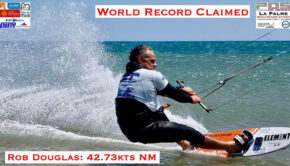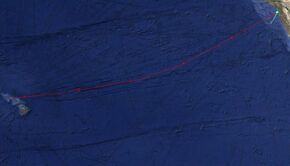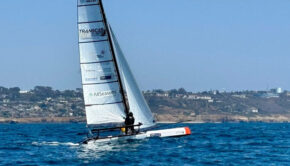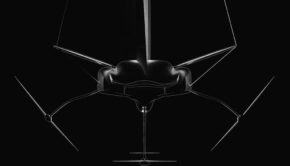Jules Verne: Making their connection
Published on January 17th, 2021
(January 17, 2021; Day 8) – Franck Cammas and Charles Caudrelier’s crew has been benefiting from ideal conditions for both the men and their 32m Maxi Edmond de Rothschild. The six sailors are slipping along on a long port tack offshore of the Brazilian coast and should pass the latitude of Cabo Frio and Rio de Janeiro at the end of the day.
Indeed, despite the SE’ly breeze easing to around 12 knots since the middle of the night, they are powering southwards at an average speed of around 20 knots. Yesterday was also very interesting purely in terms of miles in the bank as it enabled the sailors of Gitana Team to rack up a lead of over 280 miles in relation to their virtual adversary.
The team has covered 4,700 miles over the ground, namely relative to the surface of the earth, at an average speed of 28 knots. When you’re aware that the latter number includes the 24 hours at a virtual standstill in the doldrums, you get a better understanding of how fast life is whizzing by for the team.
This long sprint southbound on port tack, which began on exiting the intertropical convergence zone, clearly marks a transition between two highlights of the descent of the Atlantic. These more ‘peaceful’ times now, which are just as quick, are much appreciated by the crew.
“The conditions are enabling us to get some rest,” reports Yann Riou from the boat. “The temperatures are neither too hot nor too cold and the combination of ordered seas and a medium wind are allowing us to make good gains along the course. We must have covered over 700 miles in one day yesterday, with around fifteen knots or so of breeze, which is very pleasing it has to be said.”
On setting sail on the crewed round the world record under sail one week ago, Franck Cammas, Charles Caudrelier and their weather router Marcel van Triest were targeting a precise date and time to the south of Brazil. The idea is to position themselves offshore of Latin America just as a front bound for the Deep South detaches itself from the continent. The race to make the connection with this train of low-pressure looks nicely on track and should take place early in the week.
Once connected, life aboard will change drastically as they hitch a ride on the express train south. Fleece layers, gloves and hats will make their comeback on the deck of the blue flying maxi-trimaran, whilst the permanent whistling of the appendages will cause the decibels to ratchet up. As such, days synonymous with a transition, like those the six members of the crew are currently experiencing, are a precious commodity for getting rest and recharging the batteries.
Position of the Maxi Edmond de Rothschild on 17 January at 07:45 UTC:
Advantage to the record: 283.4 nm
Speed: 21.3 knots
Course: 180°
Team information – Tracker – Facebook
Since their start on January 10 at 01:33 UTC, to beat the round the world record of 40:23:30 set in 2017 by Francis Joyon and the crew of Idec Sport, they must finish prior to February 20 at 00:03:15 UTC.
Crew list:
Franck Cammas and Charles Caudrelier, skippers
David Boileau, trimmer/bowman
Erwan Israël, helm/trimmer
Morgan Lagravière, helm/trimmer
Yann Riou, trimmer/media man
Source: Gitana Team
The rules for the Jules Verne Trophy are simple – it is for the fastest time around the world by any type of yacht with no restrictions on the size of the crew, starting and finishing from the exact line between the Le Créac’h Lighthouse off the tip of Brittany and the Lizard Point in Cornwall. It was first won in 1993, with all nine winners as either catamarans or trimarans. The current challenge is to beat the record time of 40 days 23 hours 30 minutes and 30 seconds set by Francis Joyon and crew on the 31.5m IDEC Sport in 2017.
Record Facts
• Start and finish: a line between Créac’h lighthouse (Isle of Ushant) and Lizard Point (England)
• Course: non-stop around-the-world tour racing without outside assistance via the three Capes (Good Hope, Leeuwin and Horn)
• Minimum distance: 21,600 nautical miles (40,000 kilometres)
• Ratification: World Sailing Speed Record Council, www.sailspeedrecords.com
• Time to beat: 40 days, 23 hours, 30 minutes and 30 seconds
• Average speed: 21.96 knots
• Date of current record: January 2017
• Holder: IDEC SPORT, Francis Joyon and a 5-man crew
Split Time References – Full Crew:
Ushant-Equator: 4d 20h 07 ‘(Spindrift 2 in 2019)
Equator-Cape Aiguilles: 6d 08h 55 ‘(Banque Populaire V in 2012)
Cape Aiguilles-Cape Leeuwin: 4d 09h 32 ‘(IDEC Sport in 2017)
Cape Leuuwin-Cape Horn: 9d 08h 46 ‘(IDEC Sport in 2017)
Cape Horn-Equator: 7d 04h 27 ‘(Banque Populaire V in 2012)
Equator-Ushant: 5d 19h 21 ‘(IDEC Sport in 2017)
Here are the nine that have held the trophy:
2017 – Francis Joyon / IDEC SPORT (31.5m) – 40:23:30:30
2012 – Loïck Peyron / Banque Populaire V (40m) – 45:13:42:53
2010 – Franck Cammas / Groupama 3 (31.5m) – 48:07:44:52
2005 – Bruno Peyron / Orange II (36.8m) – 50:16:20:04
2004 – Olivier De Kersauson / Geronimo (33.8m) – 63:13:59:46
2002 – Bruno Peyron / Orange (32.8m) – 64:08:37:24
1997 – Olivier De Kersauson / Sport-Elec (27.3m) – 71:14:22:08
1994 – Peter Blake, Robin Knox-Johnston / Enza New Zealand (28m) – 74:22:17:22
1993 – Bruno Peyron / Commodore Explorer (28m) – 79:06:15:56









 We’ll keep your information safe.
We’ll keep your information safe.